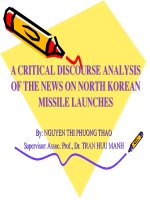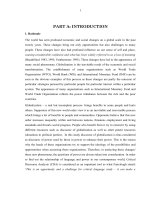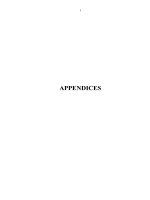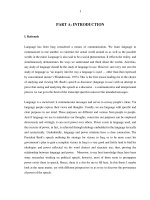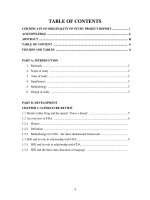A critical discourse analysis of education talks by Sir Ken Robinson
Bạn đang xem bản rút gọn của tài liệu. Xem và tải ngay bản đầy đủ của tài liệu tại đây (160.63 KB, 8 trang )
A critical discourse analysis of education talks
by Sir Ken Robinson
Trần Thị Long
Trường Đại học Ngoại ngữ
Luận văn ThS. Chuyên ngành: English linguistics; Mã số: 60 22 15
Người hướng dẫn: Prof. Nguyen Hoa
Năm bảo vệ: 2013
Keywords: Phân tích diễn ngôn; Tiếng Anh; Ngôn ngữ học
Content
PART A: INTRODUCTION
1. Rationale
Language has been playing a very important role in the development of mankind through the
history of society. We use language to communicate with others. Language helps us to express
inner thoughts and emotions, make sense of complex and abstract thoughts. It also helps us to
establish and maintain relationship. Moreover, it is a tool to help us get what we want and need.
Therefore we usually use language with specific and clear purposes in our mind. We know we
can transmit our ideas and affect other people’s mind through ideology embedded in the
language lexically and syntactically. Thus, it is undoubted that language and power have a close
connection. Language can be a tool for social change. On the other hand, language is shaped by
social structure.
Critical discourse analysis (CDA) is an approach of discourse analysis which is based on a
speech act theory that says that language is used not only to describe things but to do things as
well (Brown and Yule, 1985). Therefore, CDA focuses on language as it is used by real people
with real intentions, emotions, and purposes. According to this approach, there is a correlation
between linguistic production and social variables because people are members of the society
and their speech is a reflection of a set of experiential, relational, and expressive values
(Fairclough, 1992). Through CDA, we can clearly see the close relations among language, power
and ideology. Moreover, Fairclough adds that CDA is an orientation towards language, which
associates linguistic text analysis with a social theory of the functioning of language in political
and ideological processes. By doing CDA, we are identifying these processes which help to
identify the internal building of discourse and the connotations it implies.
In this paper, I will examine two talks delivered by Sir Ken Robinson at TED (Technology,
Entertainment, Design) conference which is a global set of conferences owned by the private
non-profit Sapling Foundation, under the slogan “ideas worth spreading”. These talks are also
put online at the website www.ted.com for those who may concern. Sir Ken Robinson, an
educationalist from England, supports teaching the arts in schools. He frequently criticizes the
current system for being too centered on math and language, and he argues traditional schooling
not only limits students’ potential, but actually destroys their creativity. He has spoken around
the world on the subject – in Europe, America, and Asia; and two of his most well-known
presentations were at a TED conference in 2006 – titled “schools kill creativity” and in 2010 –
titled “bring on the learning revolution”.
I will analyze these talks, using as a base, the framework for CDA described by Fairclough
(1989), which I feel provides a suitable set of analytical questions for the data I have chosen. The
speaker of these talks does not belong to authority system as other speakers of political talks;
thus he also has less power on the audience. However, language is still an effective tool for him
to transmit his ideas and affect the audience. Therefore, when analyzing these talks I also focus
more on the relation between discourse and ideology.
2. Significance of the study
Political and social-matter-related discourses are considered to be the targets of CDA. Plenty of
speeches on these issues by George Bush, Barack Obama, Al Gore, Hillary Clinton, etc. have
been critically analyzed. However, there is no CDA of speeches delivered by Sir Ken Robinson
though he is a well-known speaker on education in the world. Moreover, social-matter-related
issues embedded in the discourses which have been critically analyzed usually are globalization,
nuclear weapon, population and anti-terrorism war, environment, etc. There is rare analysis on
the issues of education, though education is also among the most concerned ones today.
Therefore, the thesis hopes to discover and prove how effective language is used to transfer
ideas, affect people’s perception about things in education in particular and affect society in
general.
3. Scope of the study
In this thesis, I only chose to analyze two talks delivered by Sir Ken Robinson at TED
conferences because they are not only among Robinson’ most popular talks but also have a
considerably large number of views on Internet. In addition, I just focus on the transcript of two
talks. Hence, the spoken version (including non-linguistic features, gesture, voice of speaking,
stress, etc.) is temporarily neglected.
The thesis is a linguistic study rather than an educational one; thus not all information
surrounding education, creativity and innovation is explored. The thesis only tries to explore the
speaker’s use of language first, then and more importantly to make explicit his ideologies of
education, creativity and innovation.
In addition, this is a CDA research and “critical” here could be understood as “having distance
to the data… and having focus on self-reflection as scholars doing research” (Wodak, 2002: 9).
That means critical discourse analysts have to take a clear stance or explicit position in
understanding and analyzing discourse. Therefore, in this thesis I take a social view to look at the
two talks by Ken Robinson because the main themes of both talks are related to social – matter
issues. However, as stated above, the main object of this study is still linguistics, not social
matters.
4. Aims of the study and research questions
By doing a critical discourse analysis of these talks, the author aims at discovering the relations
among language, power, and ideology, especially the relations between language and ideology,
then finding out the ideas of the speaker implied by the language he uses, and prove how he can
use language as a tool of action.
To fulfill these purposes, the following questions should be answered:
1. What and how is Robinson’s ideology (and/or power) reflected lexically and syntactically
in the talks?
2. What is the relationship between texts, their producers and consumers and the social
environment in which text production and interpretation occur?
5. Methodology
This study uses, as a base, the analytical framework of Fairclough. It includes three discourse
analysis stages: description, interpretation, and explanation. This framework will be described in
detail in part B, chapter 1, and section 1.4.
Quantitative and qualitative methods are also employed through three stages, with the dominance
of the later. Quantitative method will be used to analyze linguistic features (vocabulary,
processes, etc.). Qualitative method will be used in the description stage to assess the effects of
such linguistic features on expressing ideology, and/or power, and the persuasiveness of the
talks. This method is also used in interpretation and explanation stage.
The data of the study, two talks, is collection from the website www.ted.com. Some of his online
articles on the websites of HuffingtonPost, The New York Time are also collected to provide
more insight in the production and interpretation of the text.
To understand more about the background of two talks, including Sir Ken Robinson – the
speaker, TED conferences, and the main theme of two talks, an overview will be provided in the
next part.
6. Background of the data
Sir Kenneth Robinson, or Ken Robinson, (born 4 March 1950) is an internationally recognized
leader in the development of creativity, innovation and human resources in education and in
business. He was Director of The Arts in Schools Project (1985–1989) which influenced the
formulation of the National Curriculum in England, Chairman of Arts work - the UK’s national
youth arts development agency (1985–1989), Professor of Arts Education at the University of
Warwick (1989–2001). In 1998, he led a UK commission on creativity, education, and the
economy and his report, “All Our Futures: Creativity, Culture, and Education”, was influential.
He was knighted in 2003 for services to education and in 2005 he was named as one of
Time/Fortune/CNN’s “Principal Voices”.
He has served as advisor to a succession of high-profile public and private organizations -
including the governments of Hong Kong and Singapore, the European Commission, and Paul
McCartney's Liverpool Institute for Performing Arts. He is currently senior advisor to the J. Paul
Getty Trust in Los Angeles.
A popular speaker at TED conferences, Robinson has given two presentations on the role of
creativity in education – “schools kill creativity” in June 2006 and “bring on the learning
revolution” in May 2010, viewed via the TED website over 18 million times (2013). Robinson’s
presentation “schools kill creativity” is the most watched TED talk of all time (2013).
TED (Technology, Entertainment and Design) founded in 1984 is a global set of conferences
owned by the private non-profit Sapling Foundation, formed to disseminate “ideas worth
spreading”. The two annual TED conferences with about 1200 participants, on the North
American West Coast and in Edinburgh, Scotland, bring together the world’s most fascinating
thinkers and doers such as Bill Clinton, Jane Goodall, Malcom Gladwell, Al Gore, Gordon
Brown, Bill Gates, Google founder Larry Page, etc., who are challenged to give the talk of their
lives (in 18 minutes or less). They address a wide range of topics within the research and practice
of science and culture, often through storytelling. Since June 2006, the talks have been offered
for free viewing online through Ted.com.
7. Design of the study
This paper consists of three main parts:
Part A: Introduction. This part contains rational, significance, scope, aims, research questions of
the study and background of the data
Part B: Development. This part includes two chapters. Chapter 1 literature review includes an
overview of discourse, critical discourse analysis, the relations among language, power and
ideology, and Fairclough’s analytical framework, including systematic functional grammar’s
roles in CDA. Chapter 2 is the CDA of two talks which consists of the textual description
(vocabulary and grammar analysis, macro structure and argumentative strategy analysis), the
interpretation (situational context, intertexual context and presuppositions) and the explanation.
Part C: Conclusion. This part includes the findings, the conclusion, and suggestion for further
study.
REFERENCES
Book references:
1. Bloor, M. & Bloor, T. (2007). The Practice of Critical Discourse Analysis: An
Introduction. London: Hodder Arnold.
2. Brown, G. and Yule, G. (1985) Discourse Analysis. Cambridge. Cambridge: Cambridge
University Press.
3. Chouliaraki (L). & Fairclough (N.). (1999) Discourse in Late Modernity: Re-Thinking
Critical Discourse Analysis. Edinburgh: Edinburgh University Press.
4. Cook G. (1989). Discourse. Oxford: Oxford University Press
5. Fairclough, N. (1989). Language and Power. London: Longman.
6. Fairclough, N. (1992). Discourse and Social Change. Cambridge: Polity Press.
7. Fairclough, N. (1995). Critical Discourse Analysis: The Critical Study of Language.
London: Longman.
8. Fairclough, N. (1995b). Critical Language Awareness and Self-identity in Education.
Discourse and Power in Educational Organizations. Cresskill, NJ: Hampton Press.
9. Fairclough, N. and Wodak, R. (1997). “Critical Discourse Analysis”, in T.van Diij (ed.),
Discourse Studies: A Multidisciplinary Introduction. Volume 2. London: Sage, 258-284.
10. Fairclough, N. (2001). Language and Power (second edition). Harlow: Longman.
11. Fowler, R. and B. Hodge (1979). Critical linguistics. Language and Control. London:
Routledge and Keegan Paul.
12. Gee, J. P. (2001). An Introduction to Discourse Analysis. London: Routledge.
13. Halliday M.A.K and Hasan R. (1976). Cohesion in English. London: Longman.
14. Halliday M.K.A. (1994). An Introduction to Functional Grammar. London: Arnold.
15. Hoey, M. (1991). Patterns of Lexis in Text. Oxford: Oxford University Press.
16. Kress, G & Leeuwen, V. T. (2006). Reading Images. The Grammar of Visual Design.
London: Routledge.
17. Laclau, E. (1980). Populist Rupture and Discourse. Screen Education, 34, 87-93.
18. Leont’ev, A. N. (1978). Activity, Consciousness, and Personality. Englewood Cliffs:
Prentice Hall.
19. Martin, J. R. & Rothery, J. (1986). Handbook of Writing Research. Oxford: Oxford
University Press.
20. Nguyễn Hoà . (2006). Phân tích Diễn ngôn Phê phán: Lý luận và Phương pháp. Hà Nội:
NXB Đại Học Quốc Gia Hà Nội.
21. Nunan D. (1993). Introducing Discourse Analysis. London: Penguin.
22. Rogers, R., Berkes, E. M., Mosley, M., Hui, D. & Joseph, G. O. Critical. (2005).
Discourse Analysis in Education: A Review of the Literature. Review of Educational
Research, 75, 365.
23. Rogers, R. (2004). An introduction to critical discourse analysis in education. New
Jersey: Lawrence Erlbaum Associates.
24. Scollon, S. (2003). “Political and Somatic Alignment: Habitus, Ideology and Social
Practice”. In Gilbert Weiss and Ruth Wodak, eds. Critical Discourse Analysis: Theory
and Interdisciplinarity. London and New York: Palgrave Macmillan. 167-98.
25. Van Dijk, T.A. (1995a). Discourse analysis as ideology analysis. In Wenden, A. and
Schaffner, C. (eds) Language and Peace (in press).
26. Van Dijk, T. A. (1998a). Ideology: A Multidisciplinary Introduction. London: Sage.
27. Van Dijk, T. A. (2001). Discourse, ideology and context. International Pragmatics
Association Conference, Budapest , Hongrie, 35, p. 11-40.
28. Van Dijk, T. A. (2005). “Contextual Knowledge Management in Discourse Production:
A CDA Perspective.” Ruth Wodak and Paul Chilton, eds. A New Agenda in (Critical)
Discourse Analysis. Amsterdam and Philadelphia: John Benjamins. 71-100.
29. Wallace, C. (2005). Critical reading in language education. London and New York:
Palgrave Macmillan.
30. Wodak, Ruth (1996). Orders of Discourse. New York: Addison Wesley Longman.
31. Wodak, R. & Ludwig, Ch. (Ed.). (1999). Challenges in a changing world: Issues in
Critical Discourse Analysis. Vienna: Passagenverlag.
32. Wodak, R. (2002). Aspect of Critical Discourse Analysis. www.uni-
koblenz.de/~dieckmann/zfal/zfalarchiv/zfal36_1.pdf
33. Wodak, R. and Meyer, M. (2009). Methods of Critical Analysis. London: Sage
Publication.
34. Yule, G. (1996). Pragmatics. Oxford: Oxford University Press.
Internet references
1. En.wikipedia.org
2. Huffingtonpost.com
3. Nytimes.com
4. Sirkenrobinson.com
5. Ted.com
6. Time.com




